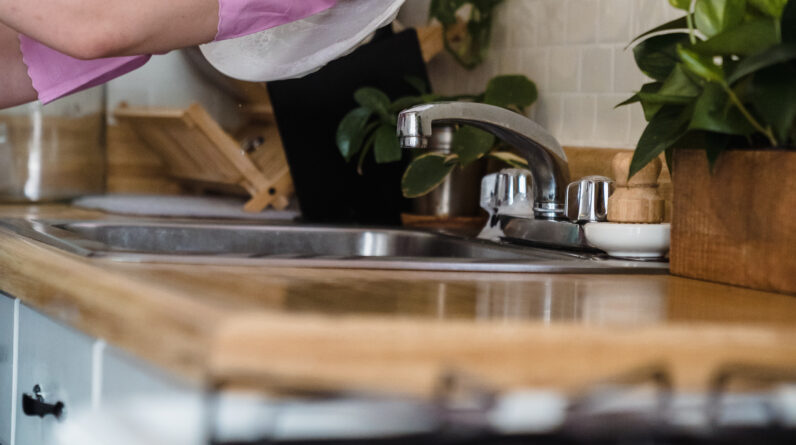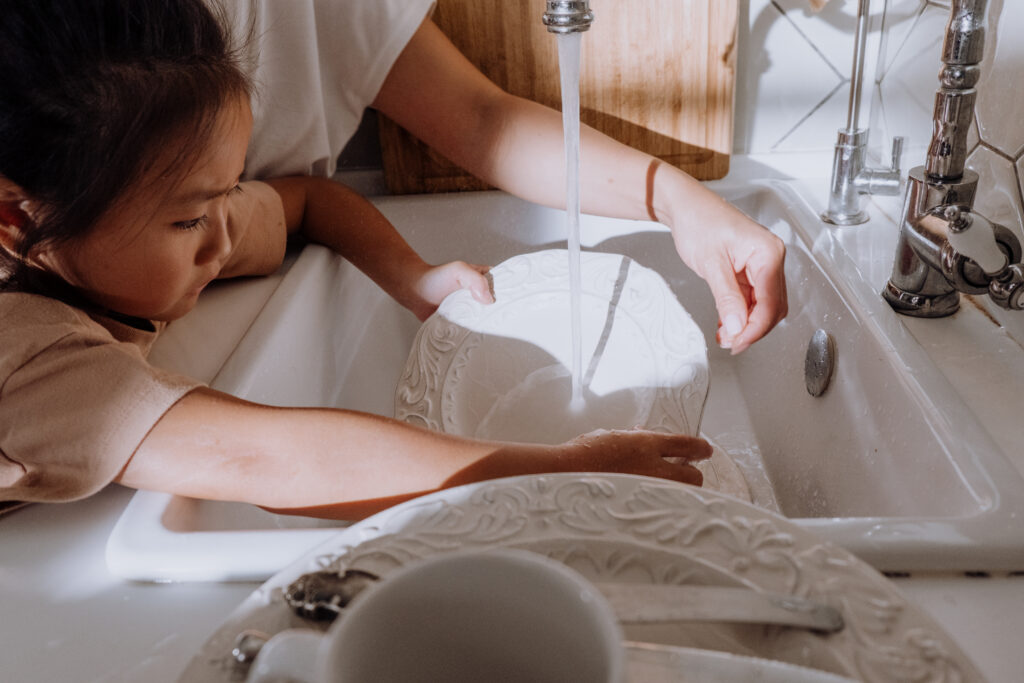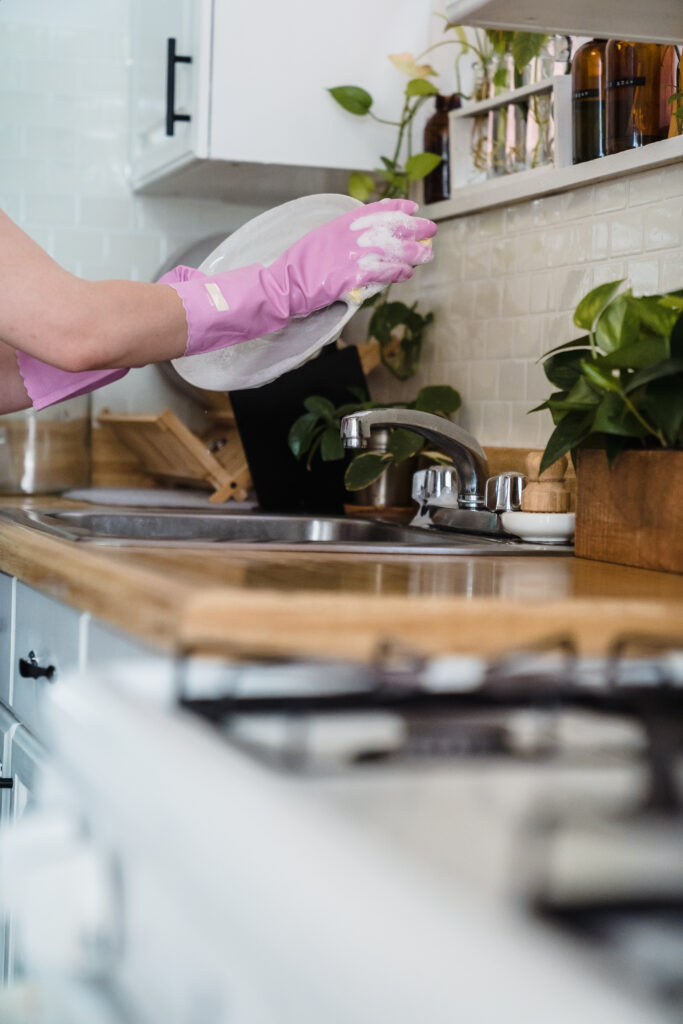
Having a dishwasher that leaves a residue on your dishes can be frustrating and time-consuming. Nobody wants to spend hours scrubbing away leftover food and soap scum. Luckily, there are some simple DIY solutions that can help solve this issue and leave your dishes sparkling clean. Whether it’s using vinegar as a natural rinse aid or cleaning the filter regularly, these tips are easy to do and can make a big difference in the performance of your dishwasher. Say goodbye to pesky residues and hello to shiny dishes with these simple tricks.

Common Causes of Residue in a Dishwasher
Hard Water Buildup
One of the common causes of residue in a dishwasher is hard water buildup. If you live in an area with hard water, it means that the water contains a high concentration of minerals such as calcium and magnesium. These minerals can accumulate in your dishwasher over time and leave behind a residue on your dishes.
Clogged Spray Arm
Another culprit behind dishwasher residue is a clogged spray arm. The spray arm is responsible for spraying water onto the dishes, ensuring a thorough cleaning. However, if it becomes clogged with food particles, debris, or mineral buildup, it can’t perform its job effectively, leading to residue left on your dishes.
Improper Loading of Dishes
Believe it or not, the way you load your dishes in the dishwasher can also contribute to residue buildup. Overcrowding the dishwasher or placing dishes in a way that blocks the spray arm’s rotation can prevent proper water circulation, resulting in residues being left behind on the dishes. It’s essential to follow the manufacturer’s guidelines for loading the dishwasher correctly to avoid this issue.
H2O Solutions
Vinegar Rinse
One effective DIY solution to tackle dishwasher residue is by using a vinegar rinse. Vinegar is a natural cleaning agent that can help break down mineral buildup and remove residue from your dishwasher. To use this method, simply pour a cup of white vinegar into a dishwasher-safe bowl and place it on the top rack of your dishwasher. Then, run a hot water cycle to allow the vinegar to work its magic.
Lemon Juice Rinse
If you prefer a fresh and citrusy solution, you can opt for a lemon juice rinse. Lemon juice contains citric acid, which can help dissolve residues and eliminate odors in your dishwasher. Squeeze the juice of a lemon into a dishwasher-safe bowl and place it on the top rack. Similar to the vinegar rinse, run a hot water cycle to let the lemon juice do its job.
Baking Soda Rinse
Baking soda is a versatile ingredient known for its cleaning properties. To create a baking soda rinse for your dishwasher, sprinkle about half a cup of baking soda on the bottom of the dishwasher. Then, run a hot water cycle to distribute the baking soda throughout the dishwasher, neutralizing odors and removing residue in the process.

Mechanical Solutions
Cleaning the Filter
The dishwasher filter plays a crucial role in preventing debris and food particles from clogging the spray arm and other components of the dishwasher. Regularly cleaning the filter is essential to maintain its efficiency. Consult your dishwasher’s manual to locate the filter and follow the instructions on how to remove and clean it properly.
Unclogging the Spray Arm
If you suspect that a clogged spray arm is causing residue buildup, it’s important to address the issue promptly. Start by removing the spray arm from the dishwasher and soaking it in warm, soapy water. Use a toothbrush or a small brush to remove any debris or mineral deposits that may have accumulated in the spray arm’s nozzles. Once cleaned, reinstall the spray arm and run a hot water cycle to check if the residue problem is resolved.
Checking Water Inlet Valve
The water inlet valve is responsible for controlling the flow of water into the dishwasher. If it malfunctions or becomes partially blocked, it can affect the dishwasher’s performance and lead to residue on your dishes. Inspect the water inlet valve for any signs of damage or blockage and clean it if necessary. If the valve is faulty, consider contacting a professional technician for a replacement.
Dishwasher Maintenance Tips
Regular Cleaning
To prevent residue buildup and maintain optimal performance, it’s important to clean your dishwasher regularly. Wipe down the interior surfaces, including the walls, door, and gasket, with a soft cloth or sponge soaked in warm, soapy water. Pay special attention to any crevices or corners where food particles or residue can accumulate.
Using Dishwasher Cleaner
In addition to regular cleaning, using a dishwasher cleaner can help remove any stubborn residue and ensure that all the components are functioning properly. Follow the instructions on the cleaner’s packaging to use it effectively. Consider using a dishwasher cleaner once a month or as recommended by the manufacturer.
Avoiding Excessive Detergent
Using too much detergent in your dishwasher can contribute to residue buildup on your dishes. The excess detergent may not fully dissolve during the wash cycle, leaving behind a film or residue. Follow the manufacturer’s guidelines for the recommended amount of detergent to use based on your dishwasher model and the hardness of your water.

Alternative Cleaning Methods
Citric Acid Solution
Similar to lemon juice, citric acid is a natural cleaning agent that can be used to tackle dishwasher residue. Mix a tablespoon of citric acid powder with water to create a solution, and then pour it into your dishwasher’s detergent dispenser. Run a hot water cycle to allow the citric acid solution to work its magic, breaking down residue and leaving your dishes clean and spotless.
Dishwasher Residue Remover
There are several commercial dishwasher residue removers available on the market that can effectively tackle stubborn residue. Follow the instructions on the packaging to use the residue remover correctly. These products are specifically designed to target residue buildup and can provide excellent results when used as directed.
White Vinegar Soak
If you’re dealing with particularly stubborn residue, a white vinegar soak can help. Fill your sink or a large container with a mixture of equal parts water and white vinegar. Submerge the affected dishes in the solution and let them soak for a few minutes or up to an hour, depending on the severity of the residue. After soaking, wash the dishes as usual in the dishwasher to remove any remaining residue.
Professional Help
Calling a Service Technician
If you’ve tried various DIY solutions and still can’t get rid of the dishwasher residue, it may be time to call a professional service technician. They have the knowledge and expertise to diagnose and resolve more complex issues that may be causing the residue problem. Contact the manufacturer or a reputable appliance repair service to schedule an appointment for a technician to inspect your dishwasher.
Checking Warranty and Insurance
Before calling a service technician, it’s a good idea to check if your dishwasher is still under warranty. If it is, contact the manufacturer to inquire about warranty coverage for repairs. Additionally, if you have appliance insurance, review your policy to determine if it covers dishwasher repairs or if it offers any assistance in dealing with residue problems.
Preventing Residue Buildup
Use Water Softener
If you live in an area with hard water, consider installing a water softener to address the issue at its source. A water softener works by removing or neutralizing the minerals that cause water hardness. By using softened water in your dishwasher, you can significantly reduce the risk of residue buildup on your dishes.
Scrape Pre-rinsed Dishes
To avoid food particles and debris from accumulating in your dishwasher, make sure to scrape pre-rinsed dishes before loading them. Remove any large food scraps or residue from plates, bowls, and utensils and dispose of them in the trash or compost. This simple habit can help prevent the buildup of residue and keep your dishwasher running smoothly.
Check Water Temperature
Ensure that the water temperature in your dishwasher is adequate to dissolve detergent and remove residue effectively. It’s recommended to set your dishwasher’s water temperature to at least 120°F (49°C) for optimal cleaning performance. If your dishwasher doesn’t have a built-in thermostat, consider using a dishwasher thermometer to monitor the water temperature and adjust as necessary.
Signs of Dishwasher Problems
Visible Residue on Dishes
The most obvious sign of dishwasher problems is the presence of visible residue on your dishes after a wash cycle. If you notice a film, spots, or cloudiness on the dishes, it indicates that your dishwasher is not cleaning them properly. It’s important to address this issue promptly to prevent further residue buildup and ensure clean and sanitized dishes.
Cloudy Glassware
Cloudy glassware is a common issue caused by residue buildup in the dishwasher. Over time, the minerals in hard water can leave a cloudy film on your glassware, making it appear dull and unattractive. If you consistently experience cloudy glassware, it may be necessary to adjust your dishwasher settings, use a rinse aid, or implement other cleaning methods to combat the problem.
Foul Odors
If your dishwasher emits unpleasant odors after a cycle, it could be a sign of residue buildup or poor maintenance. Residue and food particles that remain in the dishwasher can start to decompose, resulting in foul smells. Regular cleaning and using odor-fighting solutions, such as vinegar or citric acid, can help eliminate these odors and keep your dishwasher smelling fresh.
Possible System Malfunctions
Faulty Heating Element
A faulty heating element can lead to residue problems in your dishwasher. The heating element is responsible for maintaining the water temperature during the wash and rinse cycles, ensuring effective cleaning and sanitization. If the element malfunctions or fails, it can result in insufficiently heated water, leading to residue being left on your dishes. Contact a professional technician to diagnose and replace the heating element if necessary.
Defective Rinse Aid Dispenser
Rinse aid is an important component in preventing residue buildup on dishes. It helps to reduce water spots, improve drying performance, and ensure that dishes come out clean and free of residue. If the rinse aid dispenser in your dishwasher is defective or not working properly, it can compromise the effectiveness of the rinse aid and contribute to residue problems. Consult a technician to inspect and repair or replace the dispenser if needed.
Worn-out Water Pump
The water pump is responsible for circulating water throughout the dishwasher during the wash and rinse cycles. If the pump becomes worn-out or damaged, it may not be able to distribute water effectively, resulting in inadequate cleaning and residue left on the dishes. A professional technician can assess the condition of the water pump and recommend repairs or replacement if necessary.
Conclusion
Experiencing residue on your dishes after running them through the dishwasher can be frustrating. However, with the right knowledge and a few DIY solutions, you can tackle the problem effectively. By addressing common causes of residue, implementing proper maintenance practices, and knowing when to seek professional help, you can ensure that your dishwasher performs at its best, leaving your dishes spotless and residue-free. Remember to regularly clean your dishwasher, avoid excessive detergent usage, and consider using alternative cleaning methods or water softeners to prevent residue buildup in the future. With these tips and tricks, you’ll be able to enjoy sparkling clean dishes every time you run your dishwasher.





